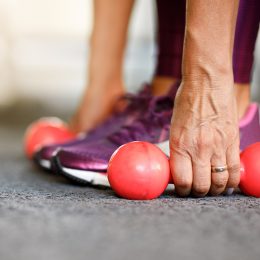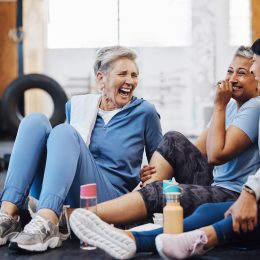13 Times It’s Okay to Ignore Your Trainer (According to Trainers)
If you hear one of these exercise cues, consider pushing back.

Your trainer may be an expert in fitness, but you’re the authority on yourself. So if a fitness professional asks you to do something that doesn’t feel right, trust your gut.
“You’re the only one who has 100 percent of the information about your body,” says Kelly Coffey, a certified personal trainer and coach who works primarily with older women. “If you’re being cued to do something that feels like it’s putting you at risk, then that is probably not an appropriate cue for you.”
Everyone is different. A good coach recognizes that and will modify your workout so it’s right for you.
“Advocate for yourself,” Coffey says. “It’s critical that you feel safe and aren’t afraid to ask questions. You’ll get a much better workout if you feel confident and safe while doing it.”
Here are 13 fitness cues you can ignore—or even push back against.
1. “Explode Up!”
This is trainer-speak for “go fast during the ‘up’ phase of a lift.” It’s good for power—the ability to move quickly with force—but for joints? Not so much.
“Weights have a ton of inertia,” says Wayne Westcott, Ph.D., a professor of exercise science at Quincy College and author of Strength Training Past 50. To stop that momentum, your joints endure a lot of stress, making them vulnerable to injury.
Exercises like medicine ball throw downs are a good alternative for building power, Westcott says. You still move quickly and forcefully, but by releasing the ball rather than working against the weight of the ball, you reduce the impact on your joints.
2. “Give Me One More Rep!”
Not sure you have it in you? Don’t push it, Westcott advises. Struggling for that last rep may compromise your form, putting you at risk for injury. Besides, you don’t need to achieve muscular failure—that’s the point when you can’t produce enough force to lift the weight—to see meaningful results.
“Training to near failure is just fine,” Westcott says. “The key is progression and consistency.”
Stop one rep short of what you think you could manage if a million dollars were on the line, he says.
3. “Breathe Out to Lift, Breathe In to Lower”
Exhaling during the hardest part of an exercise helps keep your blood pressure in the safe zone, Westcott says. But if it doesn’t feel natural and you’re stressing over when to breathe, just remember: “The main thing is always keep breathing,” he says.
Your breath should be a tool, not a stressor. If thinking about your breathing pattern takes your focus away from your exercise form, it’s no longer helping.
What else you can do: Practice good breathing by itself so it feels more natural. Good breathing technique can improve your overall health and ease tension throughout your whole body. Check out these simple breathing exercises.
4. “Never Let Your Knees Go Past Your Toes”
New research suggests allowing your knee to track forward past your toes during exercises like squats and lunges is not as bad as we used to think.
While it does put a bit of extra stress on the injury-prone knee joints, restricting forward knee movement—that is, not letting them go past your toes—can put a lot more stress on your hips and lower back.
That’s bad for many reasons, but particularly because musculoskeletal pain affects 65 to 85 percent of older adults, with lower back pain being the primary complaint leading to mobility and functional limitations, according to a 2018 review.
Plus, for some people, it’s natural for the knee to track slightly forward of the toes during squats and lunges.
A better cue: When performing squats, lunges, and stepups, focus on keeping your weight in the heel and mid-foot. This will ensure that if and when your knees do move slightly forward, the weight of your body won’t get dumped into them.
5. “Burn Off Those Cocktails from Last Night!”
Any advice that promotes an “exercise to eat” mentality can lead to obsession and disorder, says Coffey, who has maintained a 150-pound weight loss for over a decade.
Plus, it may trick you into thinking you can eat whatever you want just because you exercised today.
“Exercise is a way to stay vibrant, energized, and capable,” Coffey says. “It’s not atonement for nutritional sins. If you’re hoping to lose 10 pounds by exercise alone, without making any other life changes, it’s not going to happen.”
Think of food as fuel and a way to nourish your body, not a debt to be repaid.
6. “Take a Full Rest Day”
Allowing your body to rest and recover is important, but that doesn’t mean you need to lie on the couch all day. Most people don’t train intensely enough that they actually need a full day of rest, Coffey says.
“Unless someone is doing heavy Olympic lifts or really intense workouts, it’s perfectly appropriate to do a bit of exercise every day,” she says.
On your recovery days, try to do what Coffey calls “intentional activity.” Go for a walk, work in your garden, or do any light, gentle activity that gets you moving. This helps you resist the “gravitational pull toward inactivity” that tends to happen with age, Coffey says.
7. “Go Heavy or Go Home!”
Yes, heavy weight can help build muscle, but high reps with lighter weights may yield the same result. In one study from McMaster University, participants who lifted heavy weights for eight to 12 reps per set saw the same amount of muscle growth as those who lifted lighter weights for 20 to 25 reps per set.
As long as you challenge your muscles—by increasing the weight or the total number of reps—you’ll recruit the muscle fibers necessary to build strength.
Not comfortable with heavier loads yet? Let your trainer know. It’s much more important to master proper form first, even if that means using lighter weights or ditching them altogether.
8. “Squat Until Your Thighs Are Parallel to the Floor”
This is just one example of a cue that may promote a range of motion you’re not capable of. Another common one: “Press the weights overhead!”
Both of these may be good advice for some people, but if you have a limited range of motion in your hips or shoulders, trying to do these things could be dangerous, Coffey says.
“Many of my clients have shoulder problems and can’t even do a shoulder press without weights,” she says. “You can work those muscles in other ways.” Check out the best and worst exercises for your shoulders.
As for squats, lower as far as you can while keeping equal weight on both feet, Coffey says. Even if you can only come down 20 degrees, you’ll still get some benefit. Still too hard? Start from a seated position, and push up just a couple inches to activate your muscles. Find more tips in our beginner’s guide to the squat.
Subscribe to our newsletter
It's quick and easy. You could be one of the 13 million people who are eligible.
Already a member? Click to discover our 15,000+ participating locations.
Follow Us
9. “No Pain, No Gain”
People sometimes use “pain” to describe the feeling of muscles working. But there’s a difference between that and what trainer Zac Martin, M.P.H., refers to as ouch-ouch-ouch pain.
“If it’s an ouch-ouch-ouch pain—sharp and sudden—that’s a sign you need to stop,” says Martin, who works primarily with older clients. “If you try to push through the pain, that can lead to injury.”
A good trainer will modify the move or choose a different one to get you results without pain.
10. “The Scale Doesn’t Lie”
Actually, it does. That’s because the number on it doesn’t reflect your body composition, or the percentages of fat, bone, muscle, and water in your body.
Even though you may be losing fat and gaining muscle, the number on the scale may stay the same. This could trick you into making common weight loss mistakes like restricting calories too much or pushing yourself too hard in the gym, Martin says.
Better barometers of success: how your clothes fit and how strong you feel. If you’re craving more immediate feedback, watch for these five signs your workout is working.
11. “You Can’t Do That”
Don’t ever let a trainer make you feel incapable simply because of your age.
“Older adults are resilient,” Martin says. “I have 90-year-old clients who can come in and bench press the entire stack on a machine. I have clients who are 60-plus who see good results with interval training—and they really enjoy it.”
You can scale any workout to suit an individual’s abilities and goals, Martin says. In fact, that’s the whole point of hiring a trainer. You should constantly be communicating to make sure your workout is safe and appropriately challenging for you.
12. “We’ll Take a Water Break Together”
Older adults don’t always hydrate as well as they should, Westcott says. That’s because your sense of thirst can become blunted with age. So you may not think to drink when you need to, leading to dehydration and putting extra strain on your heart.
Don’t wait for your instructor to prompt you to drink. Carry a water bottle with you, and take sips throughout your workout, Westcott suggests.
As always, if you have a chronic condition or take any medications, talk to your doctor about how to exercise safely and your overall fluid intake.
13. Anything That Makes You Feel Unsafe
Does the thought of pressing a barbell over your head conjure images of a broken nose? Speak up.
Try phrasing it like this: “What is the benefit of training the muscle this way versus a way that would make me feel safer?” More than likely, there are plenty of equally effective alternatives.
Check Your SilverSneakers Eligibility Instantly
SilverSneakers gives you free, unlimited access to more than 16,000 gyms and fitness centers across the nation, plus classes and tools designed to keep older adults strong and independent. Check your eligibility instantly here.
Already a member? Get your SilverSneakers member ID and exclusive content by logging in to or creating your online account here.





